The Three Hares, Mogao Cave 407 Ceiling, Sui dynasty (581–618), China. Overlay of Triquetra geometry by Lori Tompkins (9 November 2023).
In
"Demystifying the Ancient Symbol of Three Fish with One Head" (March 2020) I mentioned the symbol of the Three Hares (aka "Tinners' Rabbits") as one of the many ancient symbols based upon the eternal law and geometry of the radius and its companion vesica piscis which together divide the circumference of the circle into three even 120° (=120° x 60' x 60" = 432,000") sections. I recently watched a video entitled
"Sacred Geometry - Exploring its Archetypal Language and Origins" by Paul Monson (a professor at Utah Valley University and president of the Utah chapter of the Institute of Classical Art and Architecture) that features an undated and unsourced woodcut print of the Three Hares iconography together with an excerpt from Lao Tzu's
Tao te Ching, verse 42.
The video presents the sacred geometry associated with the numbers 1-12, as found in nature, art, and architecture, beginning with the "Monad", "Dyad", and "Triad". The geometry of the Monad is illustrated as one circle with its center point, the Dyad as two circles overlapping upon their two center points forming the vesica piscis, and the Triad as three circles overlapping upon their three center points forming three vesicae piscium and an inner "Reuleaux" triangle.
Monson did not discuss the fact that the Triad of circles and vesicae piscium he illustrated is the geometric basis of the "Triquetra".
"The triquetra is a geometric figure consisting of three mutually intersecting vesica piscis lens shapes, as illustrated [right]. The central region common to all three lenses is a Reuleaux triangle." ‒ "Triquetra", Wolfram Math World
I will apply the geometry of the triquetra to the Three Hares woodcut print above a little further on. The source material for Monson's video includes and follows the chapter framework of Michael S. Schneider's book,
A Beginners Guide to Constructing the Universe, which I read in early 2010 and still have on my bookshelf. In Schneider's Chapter Three, entitled "Triad: Three-Part Harmony", he illustrated the triad of three interwoven circles and vesicae piscium in relation to the "threefold weave of primary colors" (
p. 53) followed a few pages later (p. 58) by an image of the earliest known instance of the Three-Fish-with-One-Head symbol as found on an Egyptian bowl dated to the 16th-11th centuries BCE (below), which I featured in "Demystifying the Ancient Symbol of Three Fish with One Head" (2020). [If any readers are aware of any earlier instances of this symbol, please notify me of such.] In this bowl, a triad of Lotus stalks and blossoms emerge out of the three angles of the fish's shared head.
Image source: G. Maspero, L'archeologie egyptienne.
Paris: Maison Quantin, 1887; p. 255, fig. 228.
Oddly enough, despite all of his discussions and illustrations of the vesica piscis, including his illustrations of the "Birth of the Triangle" as shown to the right (p. 38), Schneider did not discuss or present illustrations of the three interwoven vesicae piscium and their indwelling and informing radii that divide the circumference of any circle into
three even 120° (= 120° x 60' x 60" = 432,000") segments. Via this geometry we see how the equilateral triangle is born within the singular circle. Once we see and understand this simple and eternal geometry and law (
sanatana dharma) of the circle, we can see the three FISH as three vesicae piscium and the three lotus stalks as the three radii that form these three "Fish".

However, even though the three vesicae piscium of the above-right circle do move through
the same EYE or center point of the circle, they do not form or share the
Reuleaux-triangle, aka "Fish Head", as found in this and in other Three-Fish-with-One-Head designs, and as found in the triquetra symbol. So the Egyptian Three-Fish and Three-Lotus bowl design appears to be something of a hybrid symbol of the geometry of the three vesicae piscium and their informing radii that divide the circle into three, and the three-vesicae-piscium triquetra formed by three equal-diameter circles with conjoined centers, nested within a larger circle. As we can see in the image above-right, the one head that the three fish share sits
within and
replicates the shape of the Reuleaux triangle formed by the three center-conjoined circles of the bowl.
After watching Monson's video, I realized that in my 2020 article wherein I discussed and illustrated the Three-Fish-with-One-Head symbol and briefly mentioned its connection with the triquetra, I had not discussed, illustrated or integrated in my consciousness, the full geometric basis of the triquetra. More specifically, I had not discussed, illustrated or integrated in my consciousness the
THREE circles within ONE larger circle that form the three-vesicae-piscium triquetra anywhere in my work. Below are a few excerpts from
"Demystifying the Ancient Symbol of Three Fish with One Head" that convey some of what I did discuss and illustrate in 2020 about these symbols.
"Whereas I did not know about the triple-fish symbol or all of the places it has appeared throughout history until early March 2020, a version of it is found in the red triquetra I constructed for the spine of my book in late 2017 featuring three overlapping or knotted [not-geometrically-precise] vesicae piscium which share a common “head”, shown below left. It is also the favicon of this blog. The center point of this triquetra can be seen as the shared eye of Three Fish....
"The triad of three vesicae piscium is portrayed in dozens upon dozens of cryptic ways in the ancient Rig Veda....

"T]he sacred geometry and Eternal Law of the radius of the circle...draws or pours out the three formative vesicae piscium (i.e. the THREE FISH) that establish the Divine Maya or sacred measure of the circle and Zodiac. Thus it can be seen that the Three Fish with One Head is a symbol of the Eternal Geometry or Eternal Law of the Vedic Rishis and of their twelve-month Yajna or Sacrificial Year (aka the Zodiac), which Vishnu’s Avatars (the first being the FISH) are periodically [yuge-yuge] tasked with recovering and preserving....
"In Mayan mythology and iconography, the three vesicae piscis are portrayed as three fire stones (or hearth stones). Another version is found in the “three hares” iconography in which three rabbits, joined at the ears, form a triangle within a circle."
After seeing Monson's video in October 2023, I proceeded to orient the three poles and equilateral triangle of the "Three Hares" woodcut print to 0°/360°, 120° and 240° degrees, and superimposed the Triad of circles (and their three vesicae piscium) within one circle upon the image.

Via this image, we can SEE that the correspondence between the architecture of this Three-Hares woodcut and the geometry of the three interwoven circles within one circle is undeniable. Each side of the equilateral triangle,—running the length of each of the three ears—, is the radius of one of the three conjoined circles. Once we know what we are looking for or looking at, the outline of the upper circle is clearly visible in the lines of the drawing itself, as highlighted in the center image above. The radius of the larger circle is found in the three partially occluded rays extending from the center of the circle through the paws of the rabbits. Below right I have illustrated and emphasized why this same triadic geometry is symbolically portrayed as Three Fish (=three vesicae piscium) with their three "tails" and their one shared head and eye.

Not knowing the date or origin of the woodcut print above, I searched for the earliest known instances of the Three Hares iconography, wondering if the same geometry applied. I found a variety of images, including the image shown to the right as found on
www.chinesepuzzes.org. This image was cropped from a larger picture of the Mogao Cave Ceiling, Cave 407, Gansu, China, dated to the Sui dynasty, 581–618 CE. In
the full design, the circle encompassing the Three-Hares is itself encompassed by two rings of lotus petals and a whirling sky or sea of
apsaras.
"The beautiful image from Cave 407 is the best known of all the three-hares designs at Dunhuang. The hares are surrounded by two bands of lotus petals against a background of celestial maidens (
feitian) [=
apsaras] flying in the same direction as the hares.... Interestingly, this is the only one of the seventeen cave images in which the three hares are clearly running in a counterclockwise direction." ‒
www.chinesepuzzes.org [Text in brackets added]
"As the symbol has striking similarities to the Triquetra, a symmetrical design of 3 interlaced arcs (literal translation '3 cornered'), we can make some symbolic connections; but even the Triquetra has diverse interpretations depending on belief systems and geography."
Before seeing what the full Mogao Cave 407 ceiling looked like, I rotated the small cropped square 45° so that one of the three rabbit heads of the inner rabbit-ear triangle was pointed up, aligned with what I mistakenly thought at the time might be one of the four cardinal points of the image. Using this orientation, I superimposed the geometry of the three-circles-within-one-circle and its corresponding triquetra upon the conjoined Three Hares.
Via this overlay, we can see that the Three Hare heads correspond to the center of each of the three inner circles which collectively fit perfectly within the design's green inner circle; and the length of the Three Hare ears corresponds to the three radii of these three circles. Moreover, the length of the long-axis of each of the three vesicae piscium corresponds to the length of each of the Three Hares' bodies.
After overlaying this geometry on the cropped excerpt of the Mogao Cave 407 Three Hares, I searched for and found the below fuller view of the inner square of the design, as presented on the People's Republic of China's State Council Information Office, and proceeded to overlayed the same geometry with no rotation of the original image.
Via this orientation of the painting, the bodies of the Three Hares form a subtle descending triangle within their circle.
If we flip the orientation of the image 180°, then the bodies of the Three Hares form a subtle ascending triangle. This ascending triangle of hares is found in the much fuller (uncropped) view of the ceiling below which shows the SQUARE that frames the circular design of the apsaras, lotuses and hares.
Image source: www.chinesepuzzles.org (Circle and Triangle overlay by Lori Tompkins, 4 December 2023)
After illustrating the descending triangle of the Three Hares within their circle, I constructed a Satkona (aka "Star of David") with its ascending and descending equilateral triangles holding the Three Hares circle perfectly in its hexagonal core (below left). This construction revealed the subtle geometry determining the tip-to-tip measure of the white lotus petals, and the diameter of their encompassing circle.
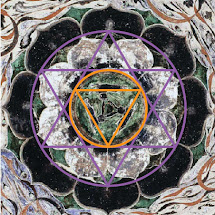
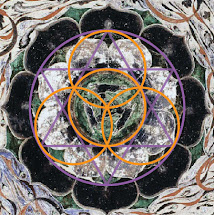
Knowing that each side of the Three-Hare's equilateral triangle corresponds to the long axis of a vesica piscis, I constructed the image above-right, illustrating the three conjoined circles and their three vesicae piscium that together measure out the three angles of the descending triangle of the central circle. In case it needs noting, all four of these circles—one central and three peripheral circles flowing through the center point of the center circle—share the same-size radius and diameter. Via this image and several of the previous images, we can see that both the geometry of the three-vesicae-piscium triquetra and the three-vesicae-piscium division of the One circle can be found in the Mogao Cave 407 ceiling painting.
Vishnu's Lotus and the Measure of the Zodiacal Vedic Year
The Vedic god Vishnu — "the Preserver" of the eternal law or s
anatana dharma of the Vedas and likewise of the 360° twelve-month Vedic Year (=Yajna) — is commonly depicted in Hindu iconography as standing on or holding a Lotus. In my writings I have discussed the Lotus as a symbol of the zodiacal Vedic Year, and I have discussed Sri Aurobindo's "Lotus of the Avatar" symbol within its enveloping Satkona as a symbol of his role as an avatar of Vishnu. Note that Sri Aurobindo's given first name
Aravind, from which the name Aurobindo arose, means Lotus. The Lotus symbol and what it symbolizes is the basis of the name of my website
www.360lotus.com. With Vishnu's Lotus and 360° sacred year in mind, I superimposed the geometry of "Vishnu's Flower" upon the eight-petal lotus rings of the Mogao Cave 407 ceiling painting in order to illustrate its overarching geometric and zodiacal architecture.
Vishnu's Flower,—which I first illustrated and named as such in 2009—
, is constructed via FIVE circles of equal diameter, including the central circle of the Zodiac and the four cardinal-point circles drawn out by the four cardinal-point radii that form the equal-armed cross of the central circle. These four cardinal-point circles and the four vesicae piscium they form
within the central circle of the Zodiac, measure out the full span of each of Vishnu's four preservation signs—Taurus, Leo, Scorpio and Aquarius—on the circumference of the zodiacal circle. Together with the four cardinal points, these four vesicae piscium give us the full 12-month measure of the Zodiac.

When the four flower petals of Vishnu's Flower are superimposed on the Mogao Cave 407 ceiling as presented on the State Council Information Office of the People's Republic of China
website, they appear to measure out not only the width of the black lotus petals, but also the position of the tips of the white lotus petals. Whereas some of these tips do not have an
exact correspondence when measuring out
the photo of the ceiling (i.e. not the ceiling itself), in my mind they are close enough to suspect that the designer utilized the geometric construction of the 12-month year (=the Vedic Yajna or "Sacrifice") as the subtle basis of his or her design.
Given that the inner circles and apsaras of this image are framed by a SQUARE (or series of squares), we can identify the four cardinal points of the black-lotus-petal ring and of the subtle circle that connects the tips of the black petals. These cardinal points of the circle, marking out 0°/360°, 90°, 180° and 270° degrees, correspond zodiacally to 0° Aries, 0° Cancer, 0° Libra, and 0° Capricorn. I have no idea what the actual North-South-East-West geographic orientation of cardinal points the Mogao Cave 407 ceiling painting is; and of course, I do not know if the designer of the image was aware of the Vedic and zodiacal sense of their geometry. Nonetheless the subtle zodiacal and Vedic geometry exists in the image. Given the square that frames the apsaras, lotuses and hares, the orientation of the Three Hares Trine and of the zodiacal cardinal points and signs as illustrated above, may be off by 90°, 180° or 270°. Due to the subtle ascending or descending equilateral triangle formed by the Three Hares, I suspect that, if the zodiacal orientation of the design is off at all, it is off by 180°.
The four intercardinal points and axes of the Earth's Solar, Tropical and Zodiacal Year,—15° Taurus, 15° Leo, 15° Scorpio and 15° Aquarius—, are found in the X connecting the points of Vishnu's four flower petals. These intercardinal points closely correspond to the tips of the four intercardinal black lotus petals, and likewise to the four midpoints of the two-petal-per-quadrant design of the white lotus circle.
Lao Tzu's Tao te Ching Verse 42 and the Axiom of Maria
"The Tao gives birth to the One,
the One gives birth to the Two,
the Two gives birth to the Three,
the Three gives birth to the Ten Thousand Things."
- Lao Tzu, Tao te Ching, Verse 42 excerpt, translated by Tolbert McCarroll
In Hu Xuezhi's translation of the same verse, that last phrase reads: "the Three gives birth to all universal things". Alternatively, K. O. Schmidt translated this line as "Out of Three the multiplicity of beings flowed which are appearance outside being inside both united by Spirit." [For more translations of this verse, see www.egreenway.com.]
I do not know who paired Lao Tzu's verse (dated to circa 400 BCE) with the Three Hares circular woodcut, or when it was paired. Regardless, it is a perfect pairing given the triadic geometry that holds the key of the Three Hares puzzle or mystery. As I have illustrated, in order to produce the geometry of the Three Hares circle and symbol as illustrated above, ONE circle bears a second circle, and those TWO circles bear a third circle, and these THREE conjoined circles bear a FOURTH (or ONE) larger circle from their triadic center point.
Via this geometry of the Three Hares,—which is also the geometry of the Three Fish with One Head—, we can better understand not only Lao Tzu's axiom, but its later rendition or offshoot, the alchemical "Axiom of Maria", dated to the 3rd century CE:
"One becomes two, two becomes three, and out of the third comes the one as the fourth."
*
"[The] Axiom of Maria is a precept in alchemy: "One becomes two, two becomes three, and out of the third comes the one as the fourth." It is attributed to 3rd century alchemist Maria Prophetissa, also called Mary the Jewess, sister of Moses, or the Copt. A more detailed quote was provided by the seventh-century alchemistic author called Christianos, who cited that what Maria uttered was "One becomes two, two becomes three, and
by means of the third and fourth achieves unity; thus two are but one". Marie-Louise von Franz also gave an alternative version, which states: "Out of the One comes Two, out of Two comes Three, and from the Third comes the One as the Fourth." The axiom served as a recurring theme associated with alchemy for over seventeen centuries." (
Wikipedia)
If we consider their shared geometric basis, the difference between Lao Tzu's version and Maria Prophetissa's version appears to be two different ways of referring to the fourth larger circle—born or manifest from its inner point that forms only after the construction of the three smaller circles. This fourth encompassing circle can be equally viewed as the One circle of the Divine Mother or Matrix who holds and harmonizes in herself the Many, i.e. "ten-thousand things" or "all universal things". The One/Fourth born of the triad of "Three" could also be seen and understood as this circles' inner point which is the compressed seed of the whole circle, as well as the compressed seed of its sacred Triad or Trinity.
Patrizia Norelli-Bachelet (Thea) did see the One/Forth of the Axiom of Maria, in terms of the inner point of the triadic circle, wherein the central Triad was the ascending equilateral triangle or Fire Trine of the Zodiac, corresponding to the entrances into each of the three Fire signs and to the numbers
9,
3, and
6 in the circle of
9:
0° Aries = 360° = 3 + 6 + 0 = 9
0° Leo = 120° = 1 + 2 + 0 = 3
0° Sagittarius = 240° = 2 + 4 + 0 = 6
She discussed this axiom, not only in relation to the sacred triadic geometry of the 360° Circle/Year, but also to the birth of the triadic Vedic Sage-Son Agni [aka Trita, the Threefold One] and Sri Aurobindo's triadic supramental descent and rebirth in 1963.
"[The supreme yogic achievement of manifesting Agni] is the yoga detailed in the Rigveda. … Sri Aurobindo had to rediscover that Vedic Yoga. His appearance as the 9 in the Solar Line was in the form of the Transcendent. His ‘sleep’ and awakening as the One is in the form of the Immanent Transcendent [Son], or the Point, the One, the Centre, Agni. To render the realisation possible and complete, the powers of 6 and 3 were conjoined to the 9. And out of that Third the One was born.
"This is the most profound mystery of creation. I have written earlier that it constituted the quest of the Alchemists of the West. This is clearly evidenced in the following Hermetic formula, taken from the dialogues between Maria [Prophetissa] and Aros (Isis and Horus?): ‘One becomes two, two becomes three, and out of the third comes the One as the fourth.’ Translated into the formula of the new cosmology, this is the 9, 6, 3, and out of the 3 comes the 1, who is the fourth in [Sri Aurobindo's Solar] Line.
Below are a few of the many ways the Triadic Oneness of the Circle was veiled by the ancient Vedic seers in cryptic verse:
"The true, Red Treasure they have sent, one only Son born of the Three [Mothers/Immortal Ones]...." ‒ Rig Veda 8.90.6, excerpt, tr. RTH Griffith
*
"When the three-[humped or three-fold] one descends with onslaught he opens wide the doors that cause man trouble." ‒ Rig Veda 1.121.4, tr. RTH Griffith
*
"Child of three Mothers, he is Lord in [assemblies]. Three are the holy Ladies of the Waters, thrice here from heaven supreme in our assembly. ‒ Rig Veda 3.56.5 excerpt, tr. RTH Griffith
*
"[Agni born as Varuna] holds the nights in his embrace; by his [Maya=measure] he established the [Three Dawns=three rivers=three mothers, etc.]. He (holds) everything in his embrace—the one lovely to see…. [He] was the measurer of the primordial place…. Who is the upholder of the worlds, who knows the secret names of the [dawns=rivers=mothers=cows], their hidden names, he is a poet who fosters the many poetic arts…. In whom are fixed all poetic arts—(he is) like the nave in a wheel. Do honor to Trita [=the Triple One=Agni] with alacrity…. Who lies on these [waters like] a cloak, while enveloping all the created things…." ‒ Rig Veda 8.41.3-7, tr. Jamison & Brereton
In conjunction with Thea's passing, I came to see and understand Agni's Three Mother's (=three rivers, goddesses, dawns, cows, sisters, etc.) as a veiled poetic description of the three vesicae piscium that flow through and measure out the Zodiac into three even parts. I likewise came to see and understand their "Son/One" Agni ‒ as the radius, pillar or
skambha of the circle, who dwells within and pours out the eternal form and law of both the circle and the vesica piscis. I have discussed this at length elsewhere and will not belabor the point here, it is just important to note for those not familiar with my book and blog, that what Thea did see and understand about the triadic geometry of the Zodiac and of Sri Aurobindo's avataric descent and yoga, opened the door for me to see and understand the circular geometric sense, divine maya (measure) and eternal law (
sanatana dharma) of Agni's three (and more prevalently seven) mothers (=rivers, goddesses, dawns, cows, sisters, etc.), who bear him as the Sage-Son of Sagittarius (=the radius of 0° Sagittarius) to his sacred goal which I see as the zodiacal location of 0° Aquarius/Kumbha (0°

).
Below I have illustrated the circular, geometric sense of Agni's mothers, whether THREE or SEVEN, who bear him to the same location (within the kshetra or field of the 360° year) referred to by the ancient Vedic seers in many ways, including the heavenly Jar or Pitcher (=kumbha, kosha, kalasha, pātra, drona, etc.), the reservoir or ocean (samudra), the gathering place of the rivers, Indra's heart, Indra's special place, Agni's resting place, the place or womb of sacrifice (yonim), and the “banquet” or “feast of the gods” (devávītaye) where the gods feast upon their immortal food, amrita or manna. This sacred feast shows up in St. John's Revelation as “the great supper of God”. This is the place and the sacred Vessel of the Vedic sacrifice wherein the rivers (cow, mares, etc.) of truth are released or poured out from the obstructive forces of collective ignorance for the benefit and sustenance of both gods and humankind.
The reason I mentioned Thea's yoga and her understanding of the Vedic and geometric sense of the Axiom of Maria is to help readers understand the Vedic sense and origin of the ancient symbol and mystery of the Three Hares, as well as the symbol and mystery of the Three Fish with One Head. Once we understand the Vedic sense of these symbols — related to the imagery of
Vishnu's Three Steps or Trivikrama) — then we can see them as symbols of not only the subtle triadic sacred geometry of the circle, but also as symbols containing in themselves the Vedic prophecy of the birth, revelation or apocalypse of the Divine Sage-Son in the Age of Aquarius/Kumbha.
If you value the original research and content made freely
available on this blog, please consider donating.



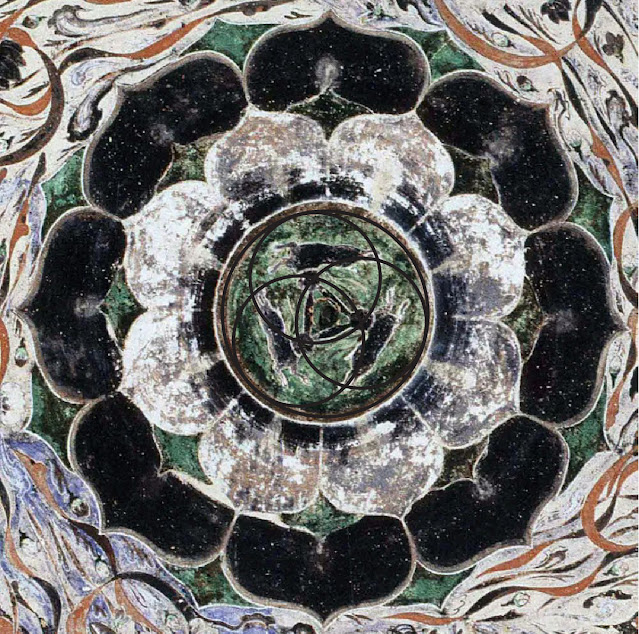


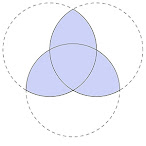


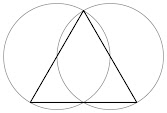










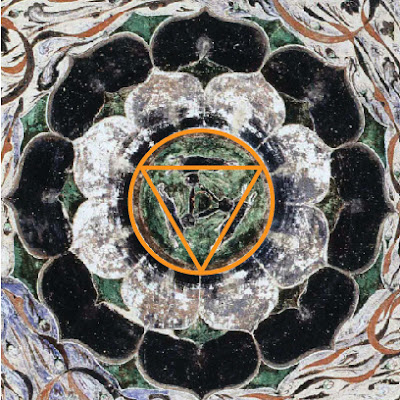










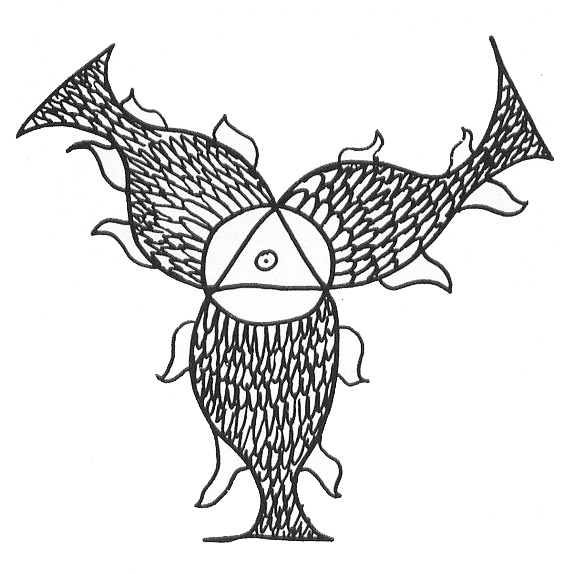
Comments
Post a Comment